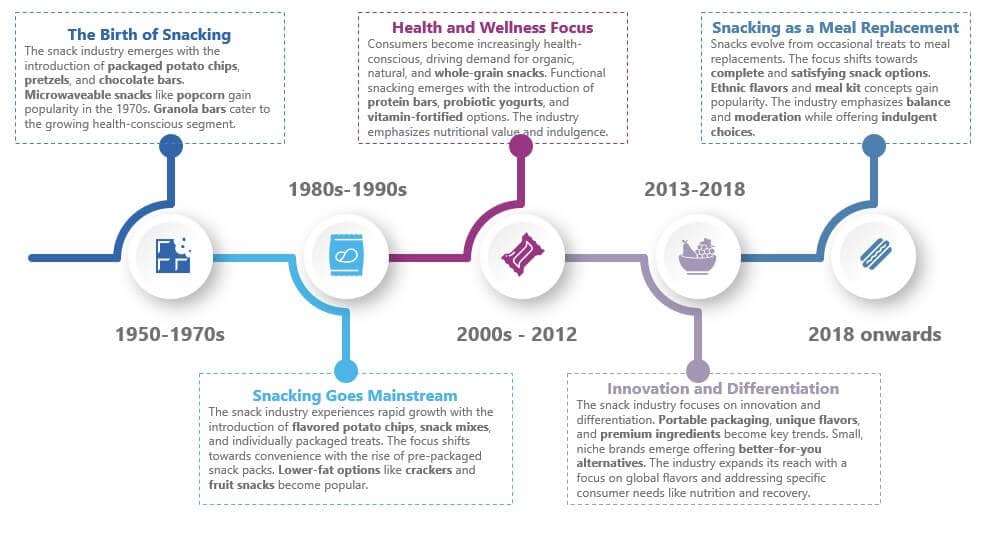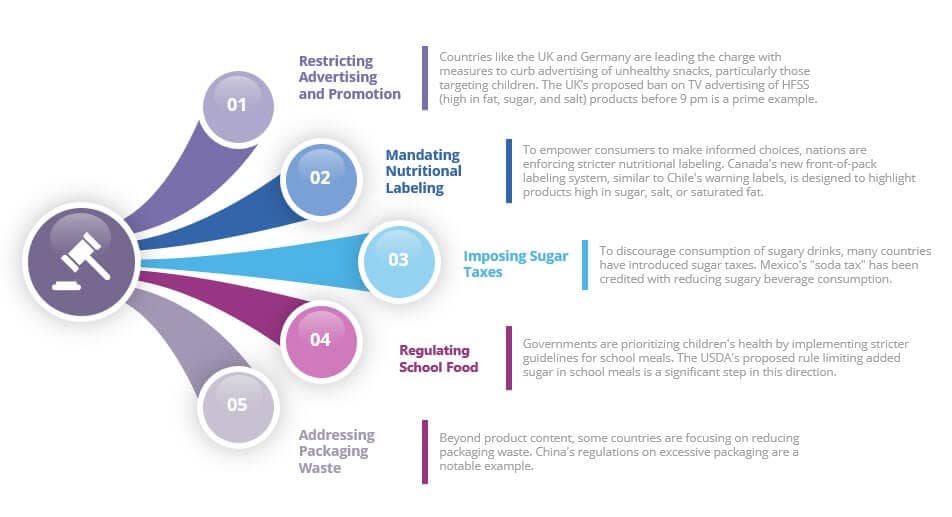What’s Next for the Snack Aisle?
Introduction
The snacking industry has undergone a remarkable evolution, transitioning from indulgent treats to essential components of modern diets. Driven by changing consumer preferences, regulatory pressures, and emerging trends, the sector is experiencing a paradigm shift. This analysis explores the dynamic landscape of the snacking industry, examining its historical trajectory, current challenges, and future opportunities. By understanding the interplay between consumer behavior, regulatory frameworks, and market trends, stakeholders can identify strategic directions for product development, marketing, and distribution.
Evolution of the Snacking Industry
The snack industry has dramatically transformed since its inception in the mid-20th century. Initially characterized by indulgent, processed options, the sector has evolved in response to changing consumer preferences and health concerns. A focus on convenience and flavor initially drove growth, but this was gradually replaced by a demand for healthier, more nutritious snacks. The industry has witnessed a shift from snacks as occasional treats to fulfilling meal replacements, with a corresponding evolution in consumer attitudes towards snacking. Today, the ideal snack is perceived as a balanced, functional food that can be enjoyed without guilt. As consumer expectations continue to rise, the snack industry is poised for further innovation, with an emphasis on sustainability, personalization, and experiential consumption.
Snacking Evolution: 1950 – Present

Impact of Regulatory Changes
The global snacking industry is undergoing a seismic shift as governments worldwide tighten regulations on products high in fat, sugar, and salt. This regulatory upheaval is driven by growing concerns about obesity, diabetes, and other health issues linked to unhealthy eating habits.
Key Regulatory Developments

These regulatory changes are forcing snack manufacturers to adapt their product formulations and marketing strategies. There is a growing emphasis on developing healthier options with reduced levels of sugar, salt, and unhealthy fats. Additionally, companies are investing in research and development to find alternative ingredients and sweeteners.
While these regulations present challenges, they also create opportunities for innovative companies to develop more healthy and appealing products. By prioritizing consumer health and complying with regulatory requirements, the snacking industry can build trust and achieve long-term sustainability.
Key Trends Shaping the Future

The snacking industry is influenced by several megatrends. Health and wellness lead with a focus on low sugar, high protein, and gluten-free options. Convenience and on-the-go trends prioritize single-serve and ready-to-eat snacks. Sustainability emphasizes eco-friendly packaging and plant-based snacks. Innovations in flavors and formats, snacking as meal replacements, and technology integration in smart packaging are also notable. Snacking for social and emotional well-being includes mood-enhancing and comfort snacks. These trends reflect shifting consumer preferences toward more healthy, convenient, and sustainable options.
To visualize sub-trends, we plotted them on a graph with profitability on the Y-axis (1 to 5) and customer popularity on the X-axis (1 to 5).


The snacking industry is evolving rapidly, driven by key trends such as health and wellness, convenience, sustainability, and innovation in flavors and formats. High-profit, high-popularity sub-trends like low-sugar and protein-rich snacks offer lucrative opportunities, while niche areas like insect snacks and meditation snacks show limited appeal. Companies that focus on the most impactful and popular sub-trends will be best positioned for growth in this dynamic market.
Consumer Behavior and Preference
Consumer preferences in the snacking category are undergoing a significant transformation. Today's consumers seek diverse, personalized, and convenient snacks that align with their health and wellness goals. As a result, the snack industry is experiencing a paradigm shift, necessitating innovative product development and targeted marketing strategies to cater to these dynamic demands. We have listed some of the key consumer preferences that dominate buying behavior-
- Snack Evolution: Consumers are branching out from classic chip options, exploring a broader spectrum of snacks like popcorn, waffles, nuts, and seeds. There's a growing emphasis on healthier alternatives.
- Indulgence with Balance: The modern consumer craves snacks that satisfy taste buds without compromising health. These indulgent yet nutritious options are consumed frequently, particularly by younger and older demographics.
- Personalized Nutrition: A one-size-fits-all snack no longer suffices. Consumers seek tailored options that align with their specific dietary needs, wellness goals, and flavor preferences.
- On-the-Go Snackification: Fast-paced lifestyles necessitate convenient snack choices that are both delicious and nourishing.
- Wellness-Centric Snacking: Health is a priority, but taste remains paramount. Consumers are opting for protein-rich snackswhile being mindful of sugar, salt, and calorie intake.
These themes highlight the importance of understanding the evolving needs of consumers in the snacking market. Snack manufacturers who can adapt their products and marketing strategies to meet these preferences will be well-positioned for success.
Innovations and Opportunities
The snacking sector presents a dynamic landscape ripe for innovation. Product differentiation and market expansion opportunities abound as consumer preferences evolve towards healthier, convenient, and sustainable options. Businesses can develop unique snack offerings by focusing on specific consumer needs and leveraging advancements in food science and technology.
For instance, catering to niche demographics like menopausal women with products rich in plant estrogens opens new avenues. Similarly, embracing sustainability by adopting recyclable packaging for plant-based ice cream bites aligns with growing environmental concerns. Reimagining classic snacks like Monster Munch with reduced salt content addresses the demand for healthier alternatives without compromising taste. Exploring unconventional ingredients such as kelp for creating antioxidant-rich chips taps into the superfood trend. Moreover, emphasizing clean label practices and sustainable sourcing, as exemplified by sea salt buckwheat crackers and small-batch organic energy bars, resonates with consumers seeking transparency and authenticity. Lastly, minimalist plant-based cookies cater to the increasing preference for simple and natural food products. By capitalizing on these opportunities and understanding consumer desires, businesses can create snack innovations that drive growth and market share.

Conclusion
The snacking industry stands at a crossroads, characterized by both challenges and immense potential. As consumer preferences continue to evolve towards more healthy, personalized, and sustainable options, the need for innovation and adaptation has never been more critical. Industry players can unlock new opportunities and drive long-term growth by aligning with emerging trends, addressing regulatory requirements, and deeply understanding consumer behavior. The future of snacking is bright for those who can successfully navigate this dynamic and complex landscape.
Contributors

Dolly Jha
Senior Analyst
Talk to One of Our Experts
Get in touch today to find out about how Evalueserve can help you improve your processes, making you better, faster and more efficient.